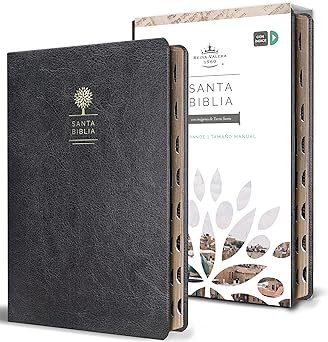The word "Bible" comes from the Greek your bible, which literally means “the books”.
It refers to a collection of sacred writings, not a single volume, and reflects the richness and diversity of genres and authors contained within.
Have you ever wondered why the Bible is called that and not just “the Book”?
Behind this common word lies a fascinating story connected to ancient papyri, lost libraries, and a message that transformed the world.
If you thought “Bible” was just a name, this article will reveal its true depth.
Introduction to the Word “Bible” – God’s Holy Book for Us
Although millions of people around the world own a Bible, few have paused to reflect on the meaning of the word that gives its name to the most influential book in history.
Here I explain why knowing the true meaning of the word "Bible" can transform the way you read and value it.
1. Do you really know what the word “Bible” means?
The word “Bible” is so common in Christian vocabulary that it is often taken for granted.
However, its original meaning reveals much about its nature and structure.
It is not just a book, but a collection of sacred writings spanning thousands of years of history and divine revelation.
Understanding what the word “Bible” really implies will help you appreciate the spiritual and literary richness it contains.
2. Why the meaning of the Bible is deeper than you imagine
Beyond a simple definition, the word "Bible" leads us to think of a set of diverse texts, written by different authors, at different times, and in different styles.
And yet, they all tell a unified story: God's relationship with humanity.
Knowing what “Bible” means is not a minor detail.
It is recognizing that you hold in your hands not just an inspired work, but a living library containing poetry, laws, letters, history, prophecy, and eternal wisdom.
3. The importance of understanding its origin and etymological value
The origin of the word “Bible” connects us to its linguistic, cultural and religious roots.
It comes from Greek and has passed through several languages before arriving in Spanish, reflecting the global diffusion of its message.
By exploring the etymological value of this word, we discover clues about how it was perceived by the first believing communities.
And this allows us to have a deeper and more reverent understanding of what it really means to open its pages.
Etymological origin of the word “Bible”
To understand the true meaning of the word “Bible,” it is essential to know its linguistic origin.
The history of this word reveals how a simple Greek expression came to represent humanity's most revered book.
1. From the Greek “ta biblía” to current Spanish
The word “Bible” comes from the Greek “τὰ βιβλία” (ta bible), which literally means “the books.”
It is a neuter plural that refers to a set of writings, not a single volume.
This term was originally used to refer to rolls or documents stored in libraries, especially in the Greco-Roman context.
Over the centuries, “ta biblía” remained a common way of referring to the sacred writings of Judaism and Christianity.
2. What does “bible” literally mean?
“Bible” is the plural of “biblion”, which in Greek means “little book” or “small book.”
In turn, “biblíon” comes from “býblos,” the name of the Phoenician city of Byblos, known for its production and export of papyrus.
Therefore, the literal meaning of “Bible” is “the books” or “the writings on papyrus.”
This etymological origin underlines that the Bible It was never intended as a single, unitary book, but as a collection of various sacred texts gathered in a single compendium.
3. Evolution of the term through Latin and ancient translations
In the transition from Greek to Latin, “ta biblía” was adopted as a feminine singular noun: “Bible”.
From there it passed to Spanish and other modern languages, now with the singular meaning of “the sacred book.”
During the Middle Ages, the word “Bible” was already commonly used to refer to the complete set of Scriptures, both in ecclesiastical and popular circles.
Early translations, such as the Vulgate Jerome also reinforced this usage, turning “Bible” into a technical term for the authorized collection of sacred books of Christianity.
Why is it called “Bible” and not simply “Book”?
To call the Bible simply “the book” would be to minimize its complexity and internal richness.
This section explains why the term “Bible” is more appropriate and profound than a simple generic term.
1. The Bible as a collection of books
The Bible is composed of 66 books in the Protestant canon, 73 in the Catholic canon, and even more so in some Orthodox traditions.
Each of these books was written by different authors, in different historical periods and with different purposes.
Genres included in the Bible:
- Historical narrative
- Poetry and psalms
- Prophecy
- Law
- Gospels
- Epistles
- Apocalyptic
That's why it is considered more of a sacred library than a single book in the modern sense.
2. Comparison with other ancient literary works
Unlike other great ancient works such as The Iliad or The Odyssey, which have a single author and a unified style, the Bible brings together a diversity of voices, styles, and contexts.
What makes the Bible unique:
- Written by more than 35 authors
- It covers more than 1,500 years of history
- It was written in three languages (Hebrew, Aramaic and Greek)
- Maintains a coherent and continuous narrative
These characteristics justify the use of the plural “Bible,” rather than referring to it as a single “book.”
3. Spiritual unity amidst literary diversity
Although the Bible is made up of multiple books, its central message is profoundly unified.
From Genesis to Revelation, all the texts converge on the revelation of God, his plan of redemption, and the person of Jesus Christ.
This spiritual thread This is what makes the Bible more than a library: it transforms it into a divine work with eternal purpose.
Thus, the name “Bible” reflects both its literary diversity as your theological unity, a balance not found in any other collection of writings in the history of humanity.
The word “Bible” in the biblical context
Although it is common today to use the word “Bible” to refer to the Holy Scriptures, it is interesting to ask whether this term appears within the biblical text.
In this section, we examine how biblical writers referred to sacred texts and what terms they used.
1. Does the word “Bible” appear in the Bible itself?
The word “Bible” as such does not appear anywhere in the original Bible, neither in the Old nor in the New Testament.
This is because the biblical texts were written long before the term “Bible” became established as the singular name for the group of sacred books.
In the original manuscripts, other expressions were used to refer to inspired texts.
The term “Bible” became established as such centuries later, mainly with the spread of Greek and Latin Christianity.
2. Equivalent terms used in the Scriptures
Instead of saying “the Bible,” biblical writers used expressions like:
- “The Law and the Prophets” – Common reference to the Hebrew canon (Matthew 5:17)
- “The sacred writings” – Allusion to the texts accepted as divine revelation (2 Timothy 3:15)
- “The Book of the Law” – Used especially in texts such as Joshua, Deuteronomy or Nehemiah
- “The Words of God” – Expression that reflects his authority and inspiration (Exodus 24:4; Revelation 22:18)
These forms of reference show that the biblical authors recognized certain writings as sacred, normative and revealed by God, although they did not yet use the term “Bible.”
3. The use of the word “Scriptures” in the New Testament
In the New Testament, the expression “the Scriptures” (Greek: hai graphai) It is the most common way of referring to the Old Testament.
Key examples:
- Jesus said, “It is written…” or “Have you not read in the Scriptures…?” (Matthew 21:42, John 5:39)
- Paul affirmed that “all Scripture is inspired by God” (2 Timothy 3:16)
This way of speaking reflects a collective recognition of the authority of certain texts, although the canon was not yet closed.
Over time, the expression “the Scriptures” became synonymous with what we call today Bible, although initially it only included the Old Testament.
How the Bible was viewed in the ancient world
Before the Bible was in its final form, it was seen, read, and transmitted in various ways in ancient communities.
This section examines the perception of sacred texts at three key moments in history: Second Temple Judaism, the Early Church, and the Middle Ages.
1. Perception among Jews of the Second Temple
During the Second Temple period (516 BC – 70 AD), the Jews They already considered certain texts as sacred and revealed by God.
These included the Torah (the five books of Moses), the Prophets, and some Writings.
Common practices:
- Public reading in synagogues
- Preservation of scrolls in sacred places
- Liturgical and legal use of the Torah
Although the complete canon was not yet closed, the authority of the Law and the Prophets was undisputed in the religious and cultural life of the Jewish people.
2. The Bible in the Early Church
The first-century Church primarily used the Old Testament in its Greek version, the Septuagint, as a reference text.
Over time, the Gospels, apostolic letters and other texts began to circulate and be read in Christian communities.
Key insight:
- The New Testament writings were gradually recognized as inspired.
- It was read along with the Hebrew Scriptures at Christian gatherings
- They were accepted as the Word of God when they came from apostles or direct witnesses of Christ.
The Early Church recognized the spiritual authority of these texts, even before a complete Bible existed in physical format.
3. Acceptance and reverence in the Middle Ages
During the Middle Ages, the Bible was consolidated as the sacred book par excellence, especially after the consolidation of the canon and the spread of the Latin Vulgate as an official translation of the Catholic Church.
Characteristics of this period:
- The Scriptures were copied by hand in monasteries with great dedication
- The copies were guarded as spiritual treasures.
- Only the clergy had direct access to the texts, which led to later reforms.
Reverence for the Bible in this period led to an almost mystical cult of the book, although access to it was limited.
This paved the way for the Protestant Reformation, who sought to make the Bible accessible to all believers.
The spiritual meaning of the Bible for the believer
For believers, the Bible is not simply an ancient text or another literary work.
It is the living voice of God speaking directly to the human heart.
In this module, we explore how the Bible becomes a constant spiritual source of transformation, direction, and revelation.
1. Living Word of God, not just literature
The Bible is not studied solely as a historical or theological document, but as a living and active word.
Hebrews 4:12 states that “the Word of God is living and active, sharper than any two-edged sword.”
Differences with other books:
- Not only is it read, but speaks to the soul
- It does not age, but adapts to every era
- Not only does it inform, but transforms
This vitality makes each reading a different experience, even if it's the same passage.
2. Source of revelation, comfort and direction
The Bible is a sure guide in a changing world.
It contains God's eternal principles that reveal His will for every aspect of life.
What Scripture offers:
- Revelation: teaches who God is and what his purpose is
- Comfort: brings hope in the midst of pain and uncertainty
- Address: offers practical wisdom for everyday decisions
That is why Psalm 119:105 says: “Your word is a lamp to my feet and a light to my path.”
3. The transformative power of Scripture
Thousands of people have experienced a radical change in their lives after encountering the Bible.
From new convictions to restoring families, The Word has the power to heal, free and renew.
Real testimonials:
- People who quit addictions by reading Proverbs
- Broken hearts that found hope in the Psalms
- Vocational or family decisions made by inspiration of the Spirit through Bible reading
The Bible not only informs, but also forms to the believer to live according to the will of God.
Is the Bible a book or a library?
Although we commonly refer to “the Bible” as a single book, it is actually a vast and diverse collection.
This module analyzes the internal structure of the Bible, demonstrating that it is a divine library with multiple voices, styles and genres.
1. Composition of 66 books (or 73 in the Catholic canon)
The Bible is not a unique document in its original form.
It is composed of 66 books according to the Protestant canon and 73 books according to the Catholic canon, including the deuterocanonical ones.
General distribution:
- Old Testament: 39 books (Protestant), 46 (Catholic)
- New Testament: 27 books (in both canons)
- Additional books in Orthodox traditions: like 3 Maccabees or the Prayer of Manasseh
This diversity reflects centuries of faithfully preserved spiritual history.
2. Diversity of literary genres: history, poetry, prophecy, gospels
One of the most fascinating aspects of the Bible is its literary wealth.
Each type of writing offers a unique way of conveying the divine message.
Main genres included:
- Historical narrative: Genesis, Kings, Acts
- Poetry and wisdom: Psalms, Proverbs, Ecclesiastes
- Prophecy: Isaiah, Jeremiah, Revelation
- Gospels and Epistles: Matthew, John, Romans, Ephesians
Each genre has its own style and purpose, making Bible reading a deeply varied and enriching experience.
3. Multiple authors, but unified message
Despite having been written by more than 35 different authors, the Bible maintains a impressive thematic unit: the redemption of humanity through God.
Author characteristics:
- They lived in different centuries and cultures
- They had different jobs: shepherds, kings, fishermen, doctors
- They wrote in three languages: Hebrew, Aramaic and Greek
Even so, their texts converge into a single message:
God seeks to redeem humanity and restore the lost relationship with Him through Jesus Christ.
Therefore, more than a simple collection of writings, the Bible is a library with one voice: the voice of God.
Differences between the Old and New Testaments
To fully understand the meaning of the Bible, it is essential to distinguish its two major divisions: the Old and New Testaments.
Although they form a single work, each part has a different structure, purpose and approach.
Here we explore their fundamental differences and their unity in divine revelation.
1. Structure, purpose and focus of each part
The Old Testament It focuses on God's relationship with the people of Israel, his covenant, his law, and the messianic promises.
It is composed of 39 books (in the Protestant canon) divided into:
- Pentateuch or Torah: the law (Genesis to Deuteronomy)
- Historical: Joshua to Esther
- Poetic and wise: Job to Song of Songs
- Prophetic: Isaiah to Malachi
The New Testament, with 27 books, reveals the fulfillment of the promises of the Old Testament through Jesus Christ.
Includes:
- Gospels: the life and teachings of Jesus
- Facts: the development of the Church
- Epistles: doctrinal and pastoral instructions
- Apocalypse: prophetic vision of the end and victory of Christ
Both testaments are deeply connected:
One establishes the bases and the other reveals their fulfillment.
2. Why “testament” and what relationship does it have with “Bible”?
The word “testament” comes from Latin testamentum, which translates Hebrew berit and Greek diatheke, both terms meaning covenant either alliance.
- Old Testament = Old Covenant between God and Israel
- New Testament = New Covenant in Jesus Christ with all who believe in Him
This division does not mean that one replaces the other, but that The New Testament completes, reveals and perfects the purpose of the Old Testament.
Together, they form the Bible, revealing a single divine plan throughout time.
3. The Bible as a history of progressive redemption
From Genesis to Revelation, the Bible tells a coherent story of redemption.
God creates, the human being falls, and from then on a plan of salvation begins that culminates in Christ.
Key stages in this narrative:
- Creation → Drop → Promise → Redemption → Restoration
The Old Testament prepares the way, and the New Testament shows the fullness of salvation in Christ.
Both wills They work in harmony to reveal the character, grace, and justice of God.
The impact of the Bible on world history
The Bible has not only transformed hearts, but also entire societies.
It has left a profound mark on the culture, law, education, and moral values of millions of people throughout the centuries.
1. Influence on laws, cultures and education
Many modern constitutions and legal systems are based on biblical principles, such as:
- The dignity of human life
- Justice, truth and respect for others
- Family structure and individual responsibility
In education:
Mass literacy in many countries began thanks to efforts to teach people how to read the Bible.
Many universities (such as Harvard and Oxford) were born with Christian roots.
In culture and art:
Masterpieces in music, painting, literature, and film have been inspired by biblical passages.
Authors such as Dante, Shakespeare and Tolstoy were deeply influenced by Scripture.
2. Translation into more than 3,000 languages
The Bible is the most translated book in history.
At the moment, More than 3,600 languages have at least one book of the Bible translated, and the number continues to grow thanks to organizations like Wycliffe and United Bible Societies.
Impact of translations:
- Preservation of indigenous languages
- Cultural and educational strengthening in remote communities
- Direct access to God's message in the language of the heart
This effort reflects the desire that all nations know God in their own language.
3. Best-selling and most widely distributed book of all time
The Bible has sold more than 5 billion copies and it is estimated that more than 100 million copies are printed each year in different formats.
Reasons for its unparalleled diffusion:
- Its universal and timeless message
- The commitment of believers who have dedicated their lives to distributing it
- Digital accessibility and global missionary work
Neither time, nor persecution, nor ideologies have been able to stop its advance.
The Bible remains the book that transforms people and nations like no other in history.
How did the concept of the “Bible” change with the printing press?
The invention of the printing press marked a before and after in the way the world accessed sacred texts.
The concept of “Bible” ceased to be reserved for handwritten copies guarded by clerics and became a work accessible to the people, profoundly changing the history of faith, education and culture.
1. From manuscripts to printed copies
Before the 15th century, each copy of the Bible was hand-copied, a slow, expensive and error-prone process.
Only churches, monasteries or wealthy individuals could have access to these manuscripts.
With the invention of the printing press by Johannes Gutenberg around 1450, the Bible became the first printed book in history.
The famous Gutenberg Bible, printed in Latin, revolutionized access to the sacred text.
Key benefits:
- Faster and more accurate reproduction
- Drastic cost reduction
- Greater uniformity in content
- Possibility of reaching thousands of people simultaneously
2. The Bible as popular access to the divine message
The printing press meant that the Bible was no longer a privilege of scholars.
Ordinary people began to read it in their native language., nourishing their faith and growing in their knowledge of God without depending exclusively on the clergy.
This democratized spirituality and created a hunger for literacy, as many wanted to learn to read just so they could understand God's Word.
Key consequences:
- Greater spiritual autonomy of the believer
- Multiplication of editions and translations
- Development of family, personal, study, and evangelistic Bibles
3. The Protestant Reformation and the spread of the Bible
The printing press was one of the most powerful tools in the hands of the 16th century reformers.
Martin Luther translated the Bible into German and, thanks to the printing press, Millions were able to access it without having to learn Latin.
Impacts of the Reformation on Biblical Dissemination:
- Promotion of translations into vernacular languages (English, French, Spanish, etc.)
- Increased circulation of Bibles across the continent
- Consolidation of the Bible as the highest authority for the Christian faith
The printing press not only changed the technical concept of the Bible as a physical object, but transformed its role in the personal, family, educational and ecclesial life of millions of believers.
Book recommendations for further study
If you want to explore more about the meaning, impact, and effective reading of the Bible, these books will guide you with depth and clarity:
📘 The Bible: A Book Like No Other – Josh McDowell
Ideal for those who want to understand why the Bible is trustworthy, unique, and transformative in its origin and message.
📙 How to Understand the Bible – John Stott
A classic for learning to correctly interpret the Scriptures and apply them to daily life from a Christ-centered perspective.
📗 The Story of the Bible – Karen Armstrong
A panoramic view of how the Bible was written, compiled, translated, and used throughout the centuries in different cultures.
This is only for Christian entrepreneurs committed to their faith.
If you're building a business with biblical purpose and values, pay attention:
God calls you to be excellent in your professional work as well.
🚀 Grow your online presence with excellence.
Launch your website, SaaS or store with NippyLaunch.com, the platform designed for entrepreneurs who want professional tools without compromising their principles.
📈 Boost your income with integrity.
Discover CleefCompany.com, where we apply digital marketing and advertising with real results and biblical foundations.
🧮 Manage your business wisely.
Visit CalculatorCCH.com to access over 600 free calculators for finance, productivity, and management, designed for entrepreneurs who want to be good stewards of their resources.
Frequently asked questions about the meaning of the Bible
What exactly does the word Bible mean?
The word “Bible” comes from the Greek your bible, which literally means “the books.”
It refers to a collection of sacred writings, not a single volume, and reflects the richness and diversity of genres and authors contained within.
What is the origin of the term and in what language?
The term has Greek origin (biblion = book, byblos = papyrus) and passed into Latin as Bible, now in the singular.
Its roots are related to the Phoenician city of Byblos, famous for exporting papyrus, the material used to write the first texts.
Is the Bible mentioned by that name in its pages?
No. The term “Bible” as such does not appear in the original texts.
Instead, expressions such as “the Scriptures,” “the Law and the Prophets,” or “the Word of God” are used.
Why are they called “books” in the plural?
Because the Bible is a collection of books written by more than 35 authors over more than a thousand years.
Each book has its own style, purpose, and context, yet they all share a unified message about God and redemption.
Is the Bible only a religious book or also a historical one?
It's both.
It has central religious value for millions of people, but also includes historical narratives, genealogies, laws, and documented events that coincide with archaeological findings.
What is the difference between “Bible,” “Scriptures,” and “Word of God”?
“Bible” refers to the set of books.
“Scriptures” is a reverent form used especially in the New Testament.
“Word of God” highlights its divine and inspirational origin, beyond the physical text.
How has the understanding of the Bible changed over time?
It went from being a series of scattered manuscripts to a complete canonical book.
With the printing press, reading became democratized, and with digital advancements, it has become accessible in all languages and on all devices.
Why do some consider the Bible a sacred library?
Because it includes multiple books of different literary genres: history, poetry, law, prophecy, letters and apocalyptic.
Furthermore, each of them reflects diverse contexts and voices, but united by divine revelation.
What makes the Bible unique from other sacred books?
Its thematic unity, its spiritual depth, its impact on history, and the coherence of its message despite having been written by such diverse authors.
It is the only book that claims to be the living Word of God inspired to transform lives.
What role does the Bible play today in a secularized world?
It remains a source of truth, direction, values and hope.
In the midst of a changing world, the Bible offers eternal principles and a transcendent vision of life and human purpose.
Conclusion
Knowing the meaning of the word "Bible" not only helps us understand its origin, but also appreciates its richness, structure, and spiritual power.
The Bible is not just a book.
It is a sacred library, a story of progressive redemption, an eternal guide for every generation.
What did you discover today about the Bible that you didn't know before?
Leave us a comment and share how this article has expanded your understanding or appreciation of Scripture.
Discover How the Bible Can Transform Your Life
- Bible Study – explore the teachings of the Bible and find answers to life’s challenges.
- Fundamental Beliefs – delves into the principles that have guided millions through the centuries.
- Spiritual Growth – Strengthen your faith with studies designed to bring you closer to God.

Discover How the Bible Can Transform Your Life
- Bible Study – explore the teachings of the Bible and find answers to life’s challenges.
- Fundamental Beliefs – delves into the principles that have guided millions through the centuries.
- Spiritual Growth – Strengthen your faith with studies designed to bring you closer to God.



























0 Comments